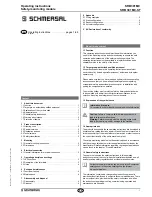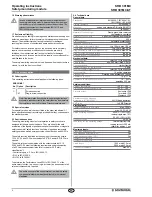
6
Operating instructions
Safety-monitoring module
SRB 301MC
SRB 301MC-ST
EN
Dual-channel control of a safety-related electronic
(microprocessor-based) safety guard with p-type transistor
outputs e.g. AOPD's to IEC 61496 (Fig. 13)
• Wire breakage and earth leakage in the control circuits are detected.
• The safety-monitoring module therefore is not equipped with a cross-
wire short detection here. The safety-monitoring module therefore is
not equipped with a cross-wire short detection here.
• Category 3 – PL e to ISO 13849-1-1 possible.
• If cross-wire shorts in the control circuits are detected by the safety
guard: Control category 4 – PL e to ISO 13849-1-1 possible.
Dual-channel control of magnetic safety switches according
to IEC 60947-5-3 (see Fig. 14)
• The control system recognises wire breakage and earth faults in the
control circuit.
• Cross-wire shorts between the control circuits are not detected.
• Category 3 – PL e to ISO 13849-1-1 possible.
Dual-channel control of magnetic safety switches according
to IEC 60947-5-3 (see Fig. 15)
• The control system recognises wire breakage and earth faults in the
control circuit.
• Cross-wire shorts between the control circuits are detected.
• Category 4 – PL e to ISO 13849-1-1 possible.
The connection of magnetic safety switches to the
SRB 301MC safety-monitoring module is only admitted
when the requirements of the standard IEC 60947-5-3
are observed.
As the technical data are regarded, the following minimum
requirements must be met:
– switching capacity: min. 240 mW
– switching voltage: min. 24 VDC
– switching current: min. 10 mA
For example, the following safety sensors meet the
requirements:
– BNS33-02z-2187, BNS33-02zG-2187
– BNS260-02z, BNS260-02zG
– BNS260-02-01z, BNS260-02-01zG
When sensors with LED are wired in the control circuit
(protective circuit), the following rated operating voltage
must be observed and respected:
– 24 VDC with a max. tolerance of –5 %/+20 %
– 24 VAC with a max. tolerance of –5 %/+10 %
Otherwise availability problems could occur, especially in
series-wired sensors, where a voltage drop in the control
circuit is triggered by LED's for instance.
S12
+24V +24V
S22
nQS
QS
S12 S22
S11 S21
nQS
QS
S12 S22
S11 S21
nQS
QS
Fig. 13
Fig. 14
Fig. 15
8.4 Actuator configuration
Single-channel control (see Fig. 16)
• Suitable for increase in capacity or number of contacts by means of
contactors or relays with positive-guided contacts.
• If the feedback circuit
is not required, establish a bridge.
•
S
= Feedback circuit
Dual-channel control with feedback circuit (Fig. 17)
• Suitable for increase in capacity or number of contacts by means of
contactors or relays with positive-guided contacts.
• If the feedback circuit is not required, establish a bridge.
•
S
= Feedback circuit
X1
X2
13
14
K
A
K
A
K
A
S
L1
N
X1
X2
13
14
K
B
K
A
K
B
K
A
K
B
L1
N
K
A
S
Fig. 16
Fig. 17

























